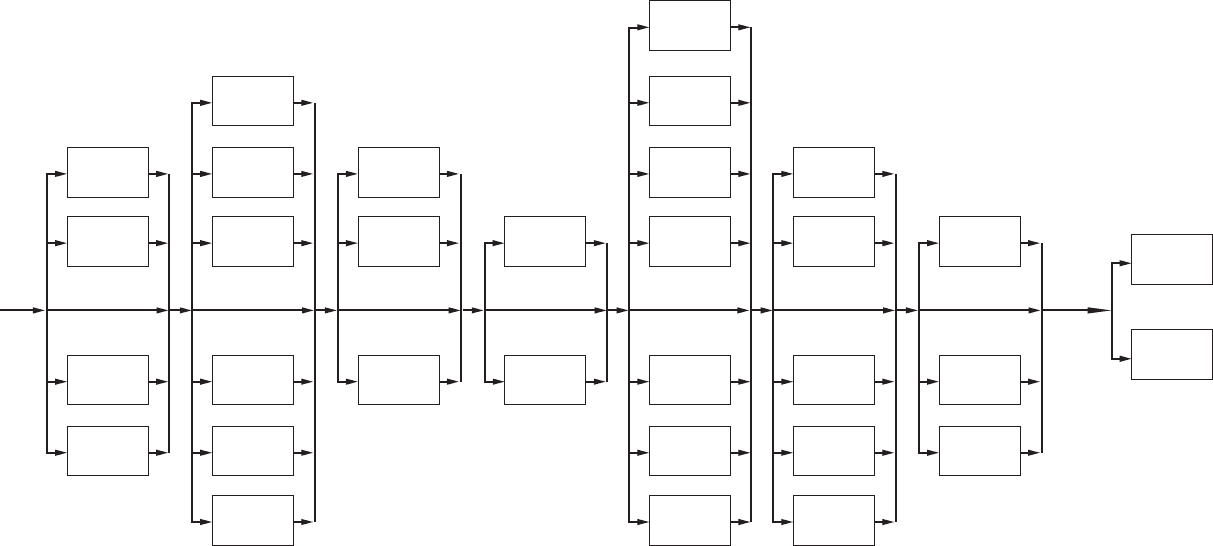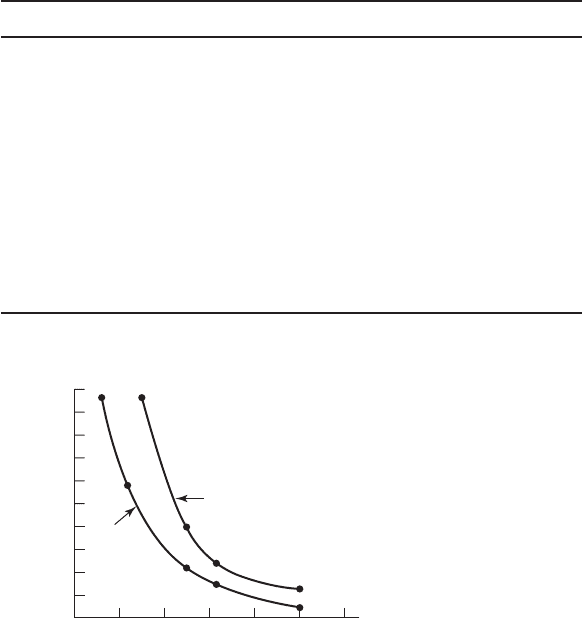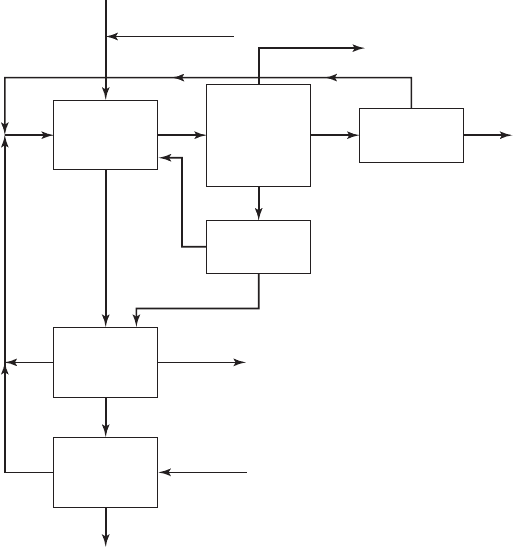Water and Wastewater Engineering
Подождите немного. Документ загружается.


WASTEWATER PLANT RESIDUALS MANAGEMENT 27-3
renewed interest with the escalating cost of commercial energy. The nitrogen and phosphorus
component of sludge is a valuable resource that can be recovered for beneficial use.
The large number of alternative combinations of equipment and processes used for treating
sludges are limited by regulatory cons
traints. The ultimate depository of the materials contained
in the sludge must either be land, air, or water. The “503” regulations, discussed in Chapter 18,
control the disposition on land. Air pollution considerations necessitate air pollution control
facilities as part of the sludge incineration process. Current regulations prohibit oc
ean dumping of
sludge or discharge to waterways.
The basic alternative routes by which these processes may be employed are shown in
Figure 27-1 . With the exception of “Heat drying and other processing” and “Thermal reduction,”
the following sections discuss the processes shown in Fig
ure 27-1 .
27-2 SOURCES AND CHARACTERISTICS OF SOLIDS AND BIOSOLIDS
In previous chapters, the disposition of the residuals has been deferred to this chapter. For conve-
nience, these are summarized in this section.
Screenings
The material called coarse screenings consists of organic and inorganic materials large enough to
be removed on bar racks. These include such items as rags, sticks, and plastic bags. In large systems
objects as large as automobile tires, logs, and carpets
may be captured by the bar racks. These
items are often coated with fecal matter. As such they are putrescible and highly odoriferous.
T ypical design properties for coarse screenings are summarized in Table 27-1 on page 27-5.
The general relationship between quantity of screenings and the size of the openings between
bars is
illustrated in Figure 27-2 on page 27-5.
Grit
True grit is inorganic material such as sand, broken glass, nuts, bolts, and metal fragments. In
wastewater terminology, it also includes other material that is not biodegradable in secondary
processes, for example, bubble gum, cigarette butts, egg shells, bone fragments, and seed
s. It is
frequently coated with grease and fecal material. It is putrescible and highly odoriferous.
The quantity of grit is highly variable. It depends on the type of sewer sy stem (separate
or combined), condition of the sewer sy stem, industrial contributions, and capture efficiency
of the grit
collec tion system . Recorded quantities range from 2.5 to 180 m
3
/10
6
m
3
of waste-
water with an average of about 28 m
3
/10
6
m
3
(WEF, 1998). The total grit storage volume is
depend ent on the frequency of removal from the plant. The following volumes are suggested
for design (WPCF, 1977):
• Storage * of 74 to 220 m
3
/10
6
m
3
of wastewater for combined sewer systems.
• Storage * of 15 to 74 m
3
/10
6
m
3
of wastewater for separate sewer systems.
A suggested conservative design value is 60 m
3
/10
6
m
3
for separate sewers (Steel and McGhee,
1979).
*“Storage” is for the short time between removal from the wastewater and transport to a sanitary landfill.

27-4
Co-settling
Gravity
Flotation
Centrifuge
Gravity
belt
Storage
Grinding
Blending
Lime
stabilization
Anaerobic
digestion
Aerobic
digestion
Chemical
Other
Degritting
Rotary
drum
Centrifuge
Inclined
screw
press
Belt-filter
press
Filter
press
Drying
beds
Reed bed
Lagoon
Direct
dryer
Indirect
dryer
Composting
Alkaline
stabilization/
pasteurization
Long-term
storage
Multiple-
hearth
incinerator
Land
application
Land fill
Fluid-bed
incinerator
Thermal
reduction
Heat drying and
other processing
DewateringConditioningStabilizationThickeningPreliminary
operations
Co-
incinerator
Solids
flow
FIGURE 27-1
Generalized sludge-processing flow diagram.
( Source: Adapted from Metcalf & Eddy, 2003.)

WASTEWATER PLANT RESIDUALS MANAGEMENT 27-5
Sources: U.S. EPA, 1987; WEF, 1998.
TABLE 27-1
Typical design properties of coarse screenings
Item Range Comment
Quantities
Separated sewer
Average 3.5–35 m
3
/10
6
m
3
Function of screen opening
and system characteristics
Peaking factor 1:1–5:1 Hourly flows
Combined sewer
Average 3.5–84 m
3
/10
6
m
3
Peaking factor 2:1– 20:1
Solids content 10–20%
Bulk density 640–1,100 kg/m
3
Volatile content 70–95%
100
90
80
70
60
50
40
Average
Maximum
30
20
10
10 20 30
Openings between bars, mm
Quantity of screnings, m
3
/10
3
m
3
of wastewater
40 5060
0
FIGURE 27-2
General relationship between volume of screenings and the size of
openings between bars.
Cautious use of this information is recommended. There are extreme variations in both the
quantity and character of the grit. A generous safety factor should be used in estimating the actual
requirements for storage, handling, and disposal of grit.
Primary or Raw Sludge
Sludge from the bottom of the primary clarifiers contains from 2 to 8 percent s olids, which is
approximately 60 to 80 percent organic matter. It has a nitrogen content in the range of 1.5 to
4 percent with a typical value of 2.5 percent as N. The phosphorus content, as P
2
O
5
, ranges from
0.8 to 2.8 percent with a typical value of 1.6 percent (U.S. EPA, 1979; Metcalf & Eddy, 2003).
This sludge rapidly becomes anaerobic and is highly odoriferous.
Secondary Sludge
This sludge consists of microorganisms and inert materials that have been wasted from the
secondary treatment processes. Thus, the solids are about 60–85 percent organic m atter. When
the supply of air is removed, this sludge also becomes anaerobic, creating noxio
us conditions if

27-6 WATER AND WASTEWATER ENGINEERING
not treated before disposal. The solids content depends on the source. Wasted activated sludge
is typically 0.5 to 2 percent solids, while trickling filter sludge contains 2 to 5 percent solids.
The phosphorus content, as P
2
O
5
, ranges from 1.5 to 3.0 perc ent (WEF, 1998). In some cases,
secondary sludges contain large quantities of chemical precipitates because the aeration tank is
used as the reaction basin for the addition of chemicals to remove phosphorus.
Tertiary Sludges
The charac teristics of sludges from the tertiary treatment processes depend on the nature of
the process. For example, phosphorus removal results in a chemical sludge that is difficult to
handle and treat. When chemical phosphorus removal occurs in the activated s
ludge process, the
chemical sludge is combined with the biological sludge, making the latter more difficult to treat.
Nitrogen removal by denitrification results in a biological sludge with properties very similar to
those of waste activated sludge.
Liquid Residuals
The major source of liquid residuals is from thickening and dewatering of biosolids. Other sources
are from grit washing and from chemicals used to clean membranes. Clean-in-place (CIP) liquid
residuals are characterized by very low pH and low volume
s.
27-3 SOLIDS COMPUTATIONS
Volume–Mass Relationships
The relationships between volume and mass that were developed in Chapter 15 also apply to
wastewater sludges.
Mass Balance
Q uantitative estimates of sludge production may be made using mass balance techniqu es. The
fundamental equation is
dS
dt
MM
in out
(27-1)
where M
in
and M
out
refer to the mass of dissolved chemicals, solids, or gas entering and leaving
a process or group of processes. Assuming steady-state conditions, then dS / dt 0 and Equation
27-1 reduces to the following:
MM
in out
(27-2)
Quantitative Flow Diagram (QFD). Several interrelated processes are examined together in
the flowsheet shown in Figure 27-3 . When labeled with mass flows, the flowsheet is called a
quantitative flow diagram (QFD). The solids mass balance can be an important aid to a designer
in predicting long-term average solids loadings on slu
dge treatment components. This allows
the designer to establish such factors as operating costs and quantities of sludge for ultimate
disposal. However, it does not establish the solids loading that each equipment item must be
capable of processing. A particular component shou
ld be sized to handle the most rigorous

WASTEWATER PLANT RESIDUALS MANAGEMENT 27-7
loading conditions it is expected to encounter. This loading is usually not determined by applying
steady-state models because of storage and plant scheduling considerations. Thus, the rate of sol-
ids reaching any particular piece of equipment does not usu
ally rise and fall in direct proportion
to the rate of solids arriving at the plant headworks.
The mass balance calculation is carried out in a step-by-step procedure:
1 . Draw the flowsheet (as in Figure 27-3 ).
2. Identify all streams. For example, Stream A contains raw sewage solids plus che
mical
solids generated by dosing the sewage with chemicals. Let the mass flow rate of solids
in Stream A be equal to A kg per day.
3. For each processing unit, identify the relationship of entering and leaving streams to
one another in terms of mass. For example, for the primary sedimentation tank, let the
ratio of solids in the tank u
nderflow ( E ) to entering solids ( A M ) be equal to E. E
is actually an indicator of solids separation efficiency. The general form in which such
relationships are expressed is:
i
mass of solids in stream
mass of solids
i
entering unit
(27-3)
For example,
Pj
P
K H
J
E
;
Primary
sedimentation
Effluent
Solids generated
by chemical
addition
B
Digestion
Supernatant
Filtrate
Dewatering
Solids destroyed
(converted to
gas and water)
JN
M
Condit
ioning
chemicals
To ultimate
disposal
Degritted sewage
solids
HP
L
K
E
A
FIGURE 27-3
Primary WWTP flowsheet. ( Source: U.S. EPA, 1979.)

27-8 WATER AND WASTEWATER ENGINEERING
The processing unit’s performance is specified when a value is assigned to
i
.
4. Combine the mass balance relationships so as to reduce them to one equation describing
a specific stream in terms of given or known quantities, or ones which can be calculated
from a knowledge of the process behavior.
E xample 27-1 illustrates the mass balance technique using the QFD.
Example 27-1. Using F
igure 27-3 and assuming that A,
E
,
j
,
N
,
P
, and
H
are known or
can be determined from a knowledge of water chemistry and an understanding of the general
solids separation/destruction efficiencies of the processing involved, derive an expression for E,
the mass flow out of the primary sedimentation tank.
Solution. The derivation is carried out as follows.
a . Define M
by solids balances on streams around the primary sedimentation tank:
E
E
AM
(i)
Therefore,
M
E
A
E
(ii)
b. Define M by balances on recycle streams:
MNP
(iii)
N
E
N
(iv)
P
H K
P
()
(v)
H
K
H
(vi)
Therefore,
P
K
P H
()1
(vii)
KJNE (viii)
Therefore,
KEJNE E EE
JN JN
()1
(ix)
and
P
PJN H
E()()11
(x)

WASTEWATER PLANT RESIDUALS MANAGEMENT 27-9
Therefore,
M
E
NP JN H
[ ( )( )] 11
(xi)
c. Equate equations (ii) and (xi) to eliminate M:
E
AE
E
A
E
N PJN H
E
N P
[ ( )( )]
(
11
1
111
J N H
)( )
E i s expressed in terms of assumed or known influent solids loadings and solids separation/
destruction efficiencies.
Once the equation for E i s derived, equations for other streams follow rapidly; in fact, most
have already been derived. These are summarized in Table 27-2 .
E x
ample 27-1was relatively simple. A m ore complex system is illustrated in Figu re 27-4 .
Mass balance equations for this system are summarized in Table 27-3 on page 27-11. For this
flowsheet the following information must be specified:
A Influent solids
X Effluent s
olids, that is, overall suspended solids removal must be specified
E
,
G
,
J
,
N
,
R
, and
T
assumptions about the degree of solids removal, addition,
or destruction
D
describes the net solids destruction/reduction or the net solids synthesis in the biologi-
cal system, and must be estimated from yield data. A positive
D
signifies net solids
destruction. A negative
D
signifies net solids growth. In this example, 8 percent of the
solids entering the biological process are assumed destroyed, that is, converted to gas
or liquified. Thus,
D
0.08.
Source: U.S. EPA, 1979.
E
A
E
NP jN H
1
1
1
()()
M
E
A
E
B (1
E
)(A M)
J
J
E
N
N
E
K E(1
J
N
)
H
H
K
P
P
(1 +
H
)K
L K(1 +
H
)(1
P
)
TABLE 27-2
Mass balance equations for F igure 27-3

27-10 WATER AND WASTEWATER ENGINEERING
Secondary
reactor/
sedimentation
tank
D
0.0800
Thickening
G
0.150
Primary
sedimentation
E
0.650
Digestion
N
0.0500
J
0.350
Dewatering
P
0.100
T
0.190
Filtration
R
0.700
Effluen
t
Treatment
chemicals
Solids destroyed
or synthesized
Degritted sewage
solids
A
O
D
R
Solids Destroyed
(converted to
gas and water)
J
H
E
K
L
Conditioning
chemic
als
To ultimate
disposal
T
CX
F
B
G
N
P
M
FIGURE 27-4
Flowsheet for a complex WWTP. ( Source: U.S. EPA, 1979.)
Note that alternative processing schemes can be evaluated simply by manipulating appropriate
variables. For example:
• Filtration can be eliminated by setting
R
to zero.
• Thickening can be eliminated by setting
G
to zero.
• Digestion can be eliminated by setting
J
to zero.
• Dewatering can be eliminated by setting
P
to zero.
• A system without primary sedimentation can be simulated by setting
E
equal to approxi-
mately zero, for example, 1 10
8
.
E
cannot be set equal to exactly zero, since division
by
E
produces indeterminate solutions when computing.
A set of different mass balance equations must be derived if flow paths between processing
units are altered. For example, the equations of Table 27-3 do not describe operations in which
the dilute stream from the thickener (Stream G ) is retu
rned to the secondary reactor instead of the
primary sedimentation tank.

WASTEWATER PLANT RESIDUALS MANAGEMENT 27-11
Source: U.S. EPA, 1979.
TABLE 27-3
Mass balance equations for Figure 27-4
E
A
X
R
R
E
1
1
⎛
⎝
⎜
⎞
⎠
⎟
()
()
Where
PJN T N
ED
()()
()()
11
11
EE
GG
()1
B
E
E
()1
E
C
X
R
1
D
D
B
F E
X
R
1
G
G
F
H (1
G
)F
J
J
(E + H)
K (1
J
N
)(E + H)
L K(1 +
T
)(1
P
)
M
E
G A
E
N
N
(E + H)
P
P
(1 +
T
)K
RX
R
R
1
T
T
K
27-4 GRIT HANDLING AND SLUDGE PUMPING
Pump Selection
Tables 27-4 and 27-5 provide guidance in selection of an appropriate pump for sludges and scum.
Headloss Determination
Grit. Slurries of grit are usually dilute. For dilute slurries, the equations that are used for estimat-
ing headloss in water pipes are adequate. A velocity of about 1.5 m/s is typically used. Low veloci-
ties may result in deposition of grit. High velocities may cause pipe eros
ion (U.S. EPA, 1979).

27-12 WATER AND WASTEWATER ENGINEERING
Type of sludge
or solids Applicable pumpComment
Ground
screenings
Pumping screenings
should be avoided
Pneumatic or screw conveyors ejectors may be used
Grit Torque flow centrifugal The abrasive character of grit and the presence of rags make grit difficu
lt
to handle. Hardened casings and impellers should be used for torque flow
pumps. Pneumatic ejectors may also be used
Scum Plunger; progressive
cavity; diaphragm;
centrifugal; chopper
Scum is often pumped by the sludge pump
s; valves are manipulated in
the scum and sludge lines to permit this. In larger plants separate scum
pumps are used. Scum mixers are often used to ensure homogeneity prior
to pumping. Pneumatic ejectors or air lift pumps may also be used
Primary s
ludge Plunger; centrifugal
torque flow; diaphragm
progressive cavity;
rotary lobe; chopper;
hose
In most cases, it is desirable to obtain as concentrated a sludge as
practicable from primary sedimentation tanks, usually by collecting
the sludge in hoppers an
d pumping intermittently, allowing the solids
to collect and consolidate between pumping periods. The character
of untreated primary solids will vary considerably, depending on the
characteristics of the solids in the wastewater and the types of treatment
units and their efficiency. Where biological treatment follows, the quantity
of solids from (1) waste-activated sludge, (2) humus sludge from settling
tanks following trickling filters, (3) overflow liquors from digestion tanks,
(4) and centrate or filtrate return from dewatering operations will also
affect the sludge characteristics. In many cases, the character of the sludge
is not suitable for the use of conventional nonclog centrifugal pumps.
Where sludge contains rags, chopper pumps may be used
Sludge from
chemical
precipitation
Same as primary
sludge
May contain large amounts of inorganic c
onstituents depending on the
type and amount of chemicals used
Trickling-filter
humus
Nonclog and torque
flow centrifugal;
progressive cavity;
plunger; diaphragm
Humus is usually of homogeneous character and can be
easily pumped
Return or waste-
a
ctivated sludge
Nonclog and torque
flow centrifugal;
progressive cavity;
plunger; diaphragm
Sludge is dilute and contains only fine solids so that nonclog pumps may
be used. For nonclog pumps, slow speeds are recommended to minimize
the breakup of flocculent particles
Thickened or
concentrated
sludge
Plunger; progressive
cavity; diaphragm;
high-pressure piston;
rotary lobe; hose
Positive-displacement pumps are most applicable for concentrated sludge
because of their ability to generate movement of the sludge ma
ss. Torque
flow pumps may be used but may require the addition of flushing or
dilution facilities
Digested biosolids
Plunger; torque flow
centrifugal; progressive
cavity; diaphragm;
high-pressure piston;
rotary lobe
Well-digested biosolids are homogeneous, containing 5 to 8% solids
and a q
uantity of gas bubbles, but may contain up to 12% solids. Poorly
digested biosolids may be difficult to handle. If good screening and grit
removal are provided, nonclog centrifugal pumps may be considered
TABLE 27-4
Application of pumps to types of sludge and biosolids
A dapted, in part, from U.S. EPA (1979).
